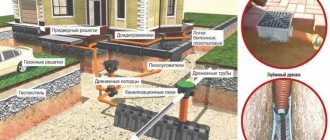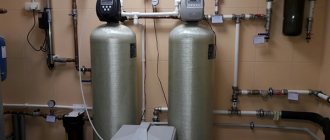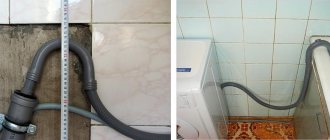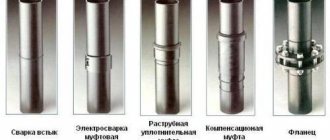Replacing a water supply or sewer system is considered a domestic disaster for many owners, and not everyone can cope with such a task due to the complexity of the process itself, as well as ignorance of the technology and methods of proper installation of pipelines. Regardless of whether the reason for repairs and replacements is leaking pipes or plans to modernize a bathroom, kitchen or entire apartment, the work must be carried out in compliance with technology and standards. Since cast iron sewerage is no longer in active use, you will need to switch to plastic. This is exactly what our material is dedicated to.
When should sewer pipes be replaced?
As a rule, in houses that have been in operation for more than twenty years, cast iron sewer pipes are installed, or a combined option is used: a cast iron riser and plastic outlets for the bathtub and kitchen. What you need to know about cast iron? This metal is susceptible to corrosion. Couplings (elbows, tees, etc.) quite quickly become overgrown with a layer of dirt and corrode faster, straight sections less so, but still, during major repairs or in the event of an accident, cast iron sewer pipes should be replaced if possible.
Old sewer pipes, especially cast iron ones, are often highly susceptible to corrosion and leaks are not uncommon. You should also examine the condition of the riser. Replacing the sewer system in an apartment cannot always ensure the guaranteed quality of the entire system in the house, and you have to think about replacing the house riser. However, if the sewer system is relatively new and made of plastic pipes, then there is no need to replace the risers. Perhaps laying a different route to the place of waste collection, or changing their location, perhaps increasing the diameter of apartment sewer pipes can solve the problem of poor-quality sewerage at a lower cost than replacing the sewer riser at home.
Expert advice
The insertion into the sewer riser is carried out using a polymer tee. When assembling a gravity sewer system, the sockets must be directed against the flow of waste.
When tightening a threaded connection, be sure to wrap tow around the threads and lubricate it with plumbing paste. Tow or FUM tape is wound along the thread in the direction of twisting.
The plastic channel does not provide complete sound insulation. The problem can be solved by installing an additional protective box.
Due to the difference in thermal expansion coefficients in cast iron-plastic joints, it is correct to use silicone as a sealant.
Plastic all around
New sewer systems these days are usually made of polyvinyl chloride (PVC) or polypropylene (PP) pipes. If you are particularly interested in dampening the sound of wastewater flow, you can use special low-noise pipes (they are expensive, however) or you can shield the sound-absorbing areas with mineral wool, foam, or simply bury the pipes in the floor or walls. You should know that risers made of plastic pipes are definitely noisier than cast iron ones, but this is usually not a problem, since they are hidden behind the decorative decoration of the premises.
Switching from cast iron to plastic drainage can be problematic for several reasons. First of all, these are different properties of materials; it is also not always possible to connect them at a high-quality level without special means, and it is also not always possible to get to the connection points to carry out work, especially in apartments where repairs have been made and emergency sewer replacement is required.
Often during the construction or modernization of sewer networks, a situation arises when it is necessary to establish a connection between the existing and the newly built sewer network. In such situations, it is necessary to connect pipes from different materials and make a transition from cast iron to plastic. Often these pipes are no longer available or at the same time technical standards have changed and such products are no longer produced, such as asbestos concrete for sewerage and even the popular cast iron.
Difficulties when connecting plastic and cast iron in a sewer system:
- Different diameters of bends, elbows, couplings of plastic and cast iron pipelines.
- Differences in installation technology and pipe connections.
- Inability to use materials for sealing cast iron pipes for plastic pipes.
- Different requirements for the rules for laying pipes made of different materials.
Preparatory work
The connection of cast iron and plastic sewer pipes is carried out in stages. First you need to prepare your workplace. Free up space in the area where repairs will be carried out. It is necessary to determine the type and quantity of components for installation. Most often, 2 standard sizes are used: 50, 110 mm. If you plan to change the sewer pipe in the toilet, use the second option. Communications with a diameter of 50 mm are installed in the bathroom.
At the next stage, the number of knees is calculated. A straight pipe is installed in an open area. If the room is small or there are incoming elements that interfere with the installation of communications, turns of 45-90° are provided. Their number varies depending on the configuration of the room. However, the more bends are installed, the more difficult the outflow of the sewer system becomes. You should not install more than 2-3 similar elements. Before starting work, it is necessary to shut off the water riser.
How to make the transition?
New sewer lines are usually installed to replace old ones, using the same channels and installation locations to minimize repair costs. PVC pipes are selected to be approximately the same diameter as those used for repairs and therefore ensure ease of installation, passage through walls and ceilings, if necessary. But the most important thing is to correctly make the transition between a plastic pipe and a cast iron pipe (bend, coupling). At this time, we can name several methods of joining cast iron and plastic, which are used in construction:
- Installation of a rubber gasket (coupling) which ensures correlation of sizes and tightness of connections of pipes of different diameters.
- Embossing using sealing agents, including flax, cement mortar, bitumen-based sealants and adhesives.
- Using plumbing silicone.
- Combining methods.
Diameter standards
For domestic domestic sewerage, cast iron pipes with an internal cross-section of 50 mm (DN) and 100 mm (DN) are used.
The dimensions of external sewerage are determined by SNiP standards. In intra-block networks, a diameter of 150 mm is used, in street networks - 200, 250 mm.
Polypropylene products are produced in accordance with GOST 26996-86. The standard has not established a specific size for the sewer sector. But in practice, the following diameters of sewer plastic pipes have developed: 32, 40, 50 and 110 mm.
For polyethylene pipes, working diameters - 40, 50, 90 and 110 mm - were determined by GOST 22689.2-89.
For PVC products, the cross-section of sewer products is regulated by GOST 51613-2000. Its requirements: PVC pipes must have a Ø from 10 to 315 mm.
In order to make drainage, lay external sewerage, septic tank pipes, you will need products with a cross-section of 110-200 mm.
Installing the rubber gasket
This is the most correct and high-quality method of transition between plastic and cast iron used in plumbing. The essence of this method is to connect two pipes using a rubber gasket selected according to the diameter. Typically, the diameter of the new sewer pipe is smaller than the internal diameter of the cast iron pipe, so PVC is required to be inserted into the cast iron pipe.
Before installation, it is necessary to thoroughly clean the installation site on the side of the cast iron pipe. After which a rubber adapter is installed into it, which will act as a holding and sealing device. To install it, you may need a sealant, as well as a certain amount of force to drive it into the outlet of the cast iron pipe for the connection. Once the adapter is installed in the cast iron pipe, the new plastic pipe can be easily inserted and ensure a secure transition between plastic and cast iron. It is advisable to ensure that the new pipe enters the old cast iron pipe at a distance of five to ten centimeters.
In addition to internal cuffs, you can also find on the market external connecting rubber couplings that can be used for pipes, the difference in diameters does not allow them to be connected by inserting one into the other.
Requirements for sewer pipe joints and connection angles
When creating a sewer system yourself, you should remember the rules for laying the pipeline. It is laid at a slight slope. This is necessary to prevent water from stagnating in the system. The slope must be at least 2 cm for each meter laid. The correct installation of pipes is checked by level.
Installed sewerage system in the floor on a slope
The weak point when laying a sewer system is the joints. Therefore, their sealing is of particular importance. After completing the assembly of the structure, the system is checked for leaks. To do this, the drain is completely filled with water. During testing, temporary plugs are placed in the revision. There shouldn't be any leakage.
Coinage
This method of transition between plastic and cast iron pipes relates more to the installation of cast iron pipes, and caulking involves performing sealing work using flax or other winding materials, followed by filling with sealant or cement mortar. The connection of pipes is made, as in the previous case, by introducing a pipe of a smaller diameter (made of PVC) inside a pipe or socket of a larger diameter (made of cast iron).
The connection technology is performed in several stages. First, a layer of glue and sealant is applied to the PVC pipe, then a layer of flax is wound and the pipes are connected, additionally embossing and stuffing of flax along the diameter is carried out for better sealing. After which the joint is filled with sealant, plumbing silicone or another composition. The difference from chasing cast iron pipes is that this method does not use hot bitumen mastics, which can damage the PVC pipe.
Step-by-step connection instructions
Let's take a closer look at the work on flange connections with your own hands. First of all, you need to prepare for the operation: decide on the sizes and types of flanges, materials, and select a tool.
Set of tools and materials
To dismantle a cast iron pipeline element you will need:
- a mallet with a rubber attachment (with a regular hammer you can easily split brittle cast iron);
- grinder for cutting cast iron pipe parts.
To install the structure you need:
- welding machine;
- plastic pipe cutter;
- plastic pipes;
- flange;
- appropriate seal;
- crimp coupling for polymer pipes;
- for cleaning the end of a cast iron pipe - a file or a cleaning disc for an angle grinder;
- a screwdriver with bolt bits or socket wrenches of a suitable size.
Work progress
- Using a grinder, cut off the end of the pipe to the required size.
- Clean it from nicks with a file or a special disk using a grinder.
- A flange is welded to the end of the cast iron pipeline.
- The crimp coupling is put on the plastic part of the structure, and its flange part is bolted to the flange of the cast iron pipe. A sealing gasket (ring) is placed between them.
Material of manufacture
Cast iron adapter
Various raw materials are used for adapters:
- cast iron;
- steel;
- polypropylene;
- polyvinyl chloride;
- rubber.
Modern fittings made of gray cast iron are coated with a bitumen mixture, which protects the pipes from corrosion and cracking due to temperature changes. The durability of the products allows them to be reused. They connect well with various types of plastic products. The disadvantage is the heavy weight of the structure.
PVC adapters connect pipes of any configuration from plumbing to the outlet in the riser. The products allow you to connect and change the flow direction, switch from one pipe size to another. Polyvinyl chloride can withstand temperatures of 60 degrees and is resistant to dissolved chemicals.
Polypropylene has a number of advantages over other materials used. The polymer can withstand temperatures of 80 degrees, and 95 degrees for a short period of one minute. In effluents, an acid-base balance pH of 2 to 12 is allowed. However, before installation, it is necessary to check the products for stability in specific conditions. Adapters made of polypropylene are resistant to corrosion and have minimal weight. The material withstands shock loads well.
Product sizes
Plastic tappers have the following running diameters:
- 50/75;
- 110/124;
- 50/75 with cuff;
- 50/72 with gasket;
- 110/124 with seal;
- 110/125 with gasket;
Polypropylene:
- transitional cuff: 50/32/50;
- Tapper 50/75 with 2 sets of seal.
Rubber Transition:
- 50/32 for connecting washing machines;
- 50/40;
Elastic products can withstand temperature changes and retain the material’s ability to stretch from 0 to 72 degrees.











